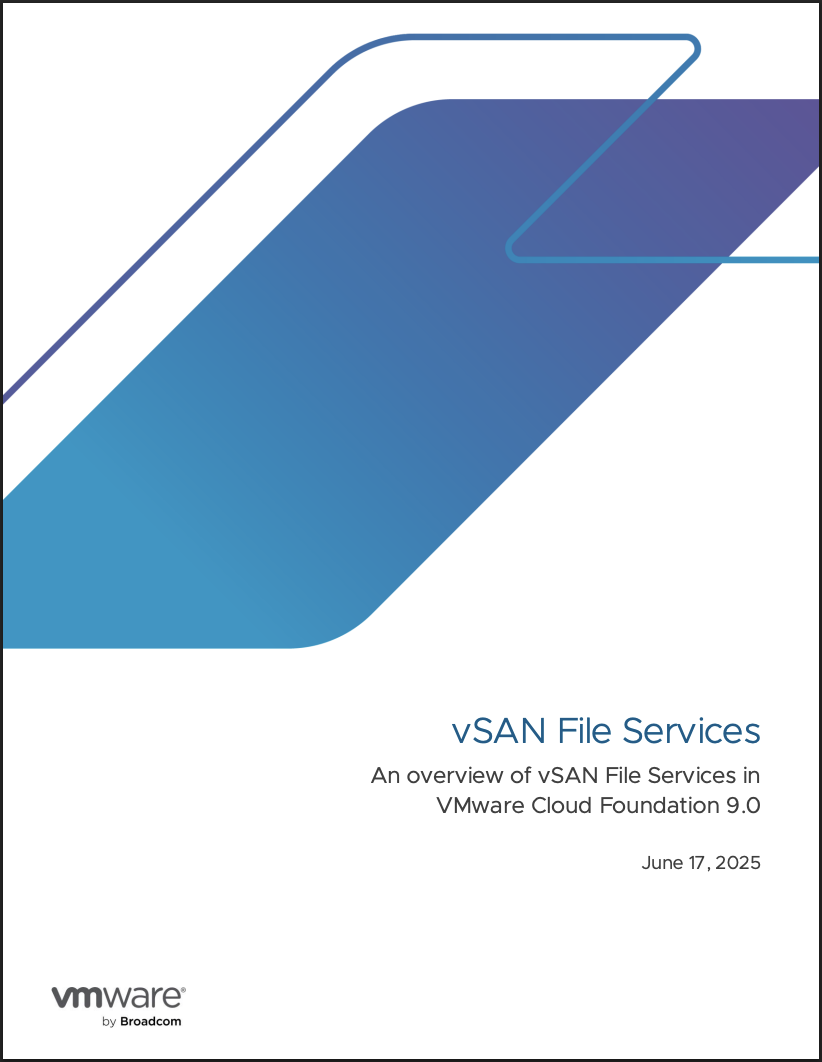 vSAN File Services in VMware Cloud Foundation 9.0 introduces a powerful and streamlined way for administrators to provide file sharing capabilities directly from within the hypervisor layer. Whether serving SMB shares to Windows clients or NFS exports to Linux systems and cloud-native applications, vSAN File Services eliminates the need for traditional filers or separate virtual appliances. Its integration with vSphere makes deployment and ongoing administration simple, with configuration and management fully accessible through the vSphere Client UI.
vSAN File Services in VMware Cloud Foundation 9.0 introduces a powerful and streamlined way for administrators to provide file sharing capabilities directly from within the hypervisor layer. Whether serving SMB shares to Windows clients or NFS exports to Linux systems and cloud-native applications, vSAN File Services eliminates the need for traditional filers or separate virtual appliances. Its integration with vSphere makes deployment and ongoing administration simple, with configuration and management fully accessible through the vSphere Client UI.
This built-in service supports up to 500 file shares per cluster, with a limit of 100 SMB shares for Windows environments. Shares are intelligently distributed across the cluster using vSAN’s Cluster-Level Object Manager, and a dedicated protocol services layer ensures fair access and automatic load balancing. vSAN File Services supports Kerberos authentication for both NFS and SMB protocols, enhancing security and integration with enterprise environments.
Mounting shares is simplified through guided syntax in the UI, providing administrators with exact commands for mounting in Linux or connecting in Windows. This feature accounts for protocol version differences, including NFS v3 and NFS v4.1, and handles the appropriate redirection for optimal access.
vSAN File Services supports multiple deployment models, including hyperconverged clusters, disaggregated storage clusters, stretched clusters, and 2-node clusters. This flexibility makes it suitable for everything from core data centers to edge sites. Administrators can configure placement policies to ensure optimal site affinity, and services are automatically balanced to maintain performance and availability.
From a management perspective, everything is handled centrally via vCenter. Administrators can adjust storage policies, set quotas, configure access controls, and monitor usage. Integrated health checks appear in Skyline Health, covering file server availability, infrastructure health, and share status. Performance metrics such as IOPS, latency, and throughput are provided per share, alongside capacity usage statistics.
Security and governance features include quota enforcement and Access Based Enumeration, which hides files and folders users do not have permission to access. These features help reduce data exposure and support compliance goals.
Architecturally, vSAN File Services runs protocol services as stateless containers within agent VMs on each host. These containers handle I/O presentation for NFS or SMB shares but do not store data. Instead, the underlying vSAN Virtual Distributed File System handles data placement and storage, using vSAN objects to represent shares and apply policies for resilience and availability.
The system uses a zero-copy data path to minimize latency and reduce processing overhead. Failover mechanisms automatically reinstantiate containers on healthy hosts if needed, and containers are rebalanced every 30 minutes based on the number of shares served.
Scaling is straightforward. Adding hosts increases both capacity and share distribution, while growing share size triggers automatic creation of additional backing objects. This allows vSAN File Services to scale up or out depending on workload requirements.
Key considerations include reserving IP addresses for containers, ensuring proper DNS setup, and selecting either NFS or SMB per share. vSAN File Services does not support presenting NFS datastores to ESXi for VM storage, and snapshot capabilities are only available via API. Replication must be performed using external tools such as rsync or Robocopy.
vSAN File Services is a modern, hypervisor-integrated solution for providing enterprise-grade file shares across a wide range of deployment scenarios. It reduces complexity, improves manageability, and offers flexible performance and capacity benefits without the cost and overhead of separate file servers or appliances. For organizations already using vSAN, enabling File Services can simplify infrastructure and consolidate storage services into a single platform.



